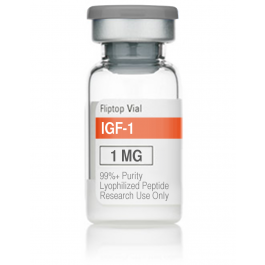The term “IGF-1″ is tossed around on bodybuilding message boards with a certain casual feel. It is often considered to be part of the long laundry list of compounds that an “All Drugs” bodybuilder would utilize to achieve his physique. However, despite this negative and often mean-spirited assumption, IGF-1 is an important compound that is present in all of us. Let’s learn more.
IGF-1 is an important component in muscle growth. It is created when HGH arrives in the liver and is processed. IGF-1 is one of the byproducts. HGH occurs naturally in the body in small amounts, which leads to small natural levels of IGF being present in the body as well. If you are a bodybuilder who uses human growth hormone in larger amounts (2 to 5 IU per day, for example), then you are going to see significantly higher levels of IGF-1, and significantly higher levels of positive side effects, which we will examine next. Many bodybuilders will supplement their HGH injections from online with IGF-1 as well.
Your muscles can only absorb so much of the amino acids from the protein in the food you eat. The greater protein uptake, the more the muscles can grow. Of those 400 grams of protein you are consuming each day, there is a likelihood that 100 to 150 grams are going to waste. IGF-1 allows more of this protein to be utilized. As with many anabolic steroids, greater protein synthesis is one of the primary goals of steroid use. IGF-1 is very helpful for this purpose.
There are two kinds of IGF-1. HuIGF-1 is fast release and very temporary. Long R3 IGF-1 has a much larger active window. You’ll use the short-term variety in specific zones needing short fixes and gains. The longer release version helps full body growth and is preferable for most users’ needs. IGF-1 accumulates in the body. Therefore you will see greater results the longer you use it. Breaks can be taken, as with all compounds, but you’ll need to closely monitor your body’s performance on blood panel tests to see if amino levels remain constant or if there are any notable drops.
IGF-1 injection is a bit more specific than HGH, which just arrives in the morning or early afternoon to offset the late-night release. On days that you train, IGF-1 should be injected into the body in the post-workout window. If you train late in the afternoon or evening, as many people do, you will need separate IGF-1 and HGh injections. This can add up to a lot of daily shots, so be prepared for this. On days that you do not train, you should inject IGF-1 immediately upon rising in the morning. Injections should be intra-muscular, using a U-100 insulin syringe and a half-inch needle.
IGF-1 has a place in the drug regimen of advanced bodybuilders, but not on the menu of newbies trying their first cycle. Spend time researching it, but don’t consider taking that first needle plunge until you’ve won a few regional shows and are ready to stand on a national stage. It’s a powerful drug that should be used only by advanced athletes.



